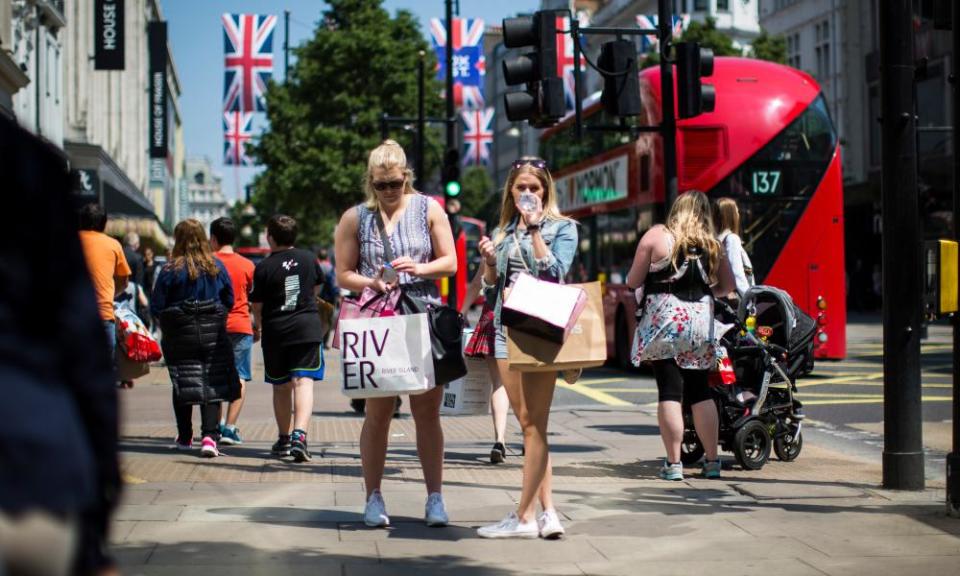Warm weather drives UK shoppers back to the high street

Retail sales rebounded in June as the sunny weather put consumers in the mood to update their summer wardrobes.
Sales rose by 0.6% last month, beating the 0.4% increase forecast by economists and following a sharp 1.1% drop in May, according to the Office for National Statistics (ONS).
While consumers splashed out on T-shirts and sandals, as well as household goods, the volume of food and fuel sales fell.
“A particularly warm June seems to have prompted strong sales in clothing, which has compensated for a decline in food and fuel sales for the month,” said Kate Davies, a senior statistician at the ONS.
A better-than-expected June pushed up retail sales by 1.5% in the second quarter overall, following a 1.4% fall in the first quarter.
Ian Geddes, head of retail at the consultancy Deloitte, said the sunny weather had brought a “Glastonbury feelgood factor” to Britain’s high streets. “The good weather has clearly boosted footfall on the high streets as well as clothing sales, which coincided with stores being full of summer lines,” Geddes said. “June’s retail numbers gave a timely boost to the second quarter, which means that the retail industry has ended the first half of the year flat, as opposed to down.”
Economists cautioned that the rebound could prove temporary amid a sustained fall in real pay as prices rise faster than wages. The first estimate of UK growth in the second quarter, published by the ONS next week, is expected to show a slight pick-up from 0.2% growth in the first quarter.
“Consumer spending has been a powerful engine of UK economic growth for the past three years, but has now lost momentum,” said Andrew Sentance, a senior economic adviser at accountancy firm PwC and a former member of the Bank of England’s rate-setting committee.
“The GDP figures for the second quarter are likely to confirm this picture of subdued economic growth. The vote for Brexit has created a more uncertain climate for business and a squeeze on consumers from higher inflation. We face the prospect of weak economic growth this year and next.”
Inflation actually fell unexpectedly in June and for the first time in nine months to 2.6% from 2.9% in May, mainly because of lower fuel prices. Reflecting the fall in inflation, the ONS said retail sales annual growth in shop prices – including petrol stations – slowed to 2.7% in June from 3.2% in May.
However, with regular pay growth excluding bonuses currently running at 1.8%, workers are suffering a sustained period of falling real pay.
Despite the weak backdrop for household finances, economists at Capital Economics said there were a number of reasons why a collapse in consumer spending was unlikely.
“The squeeze in real wages looks likely to intensify as inflation continues to rise to around 3%. However, nominal spending should continue to hold up well, supported by strong employment growth, resilient consumer confidence and low borrowing costs.
“In any case higher inflation should prove transitory, falling back to 2% by the end of 2018. Indeed, there are already signs that the effect of the weaker pound on retailers’ costs is starting to wane. As such, while we are forecasting a slowdown in real consumer spending growth, a collapse looks unlikely.”
Alan Clarke, an economist at Scotiabank, said a rise in retail sales in June was unlikely to convince Bank policymakers that the time was right to raise interest rates.
“While today’s reading is welcome news and may limit any further downside to GDP growth during the second quarter, I doubt that the middle ground on the Bank’s monetary policy committee is going to get more hawkish on the back of sales of paddling pools and flip-flops,” he said.
Clarke predicted the MPC would leave UK interest rates on hold at an all-time low of 0.25% at its next policy meeting in August, despite inflation being well above the Bank’s 2% target and forecast to climb higher.

 Yahoo Finance
Yahoo Finance 